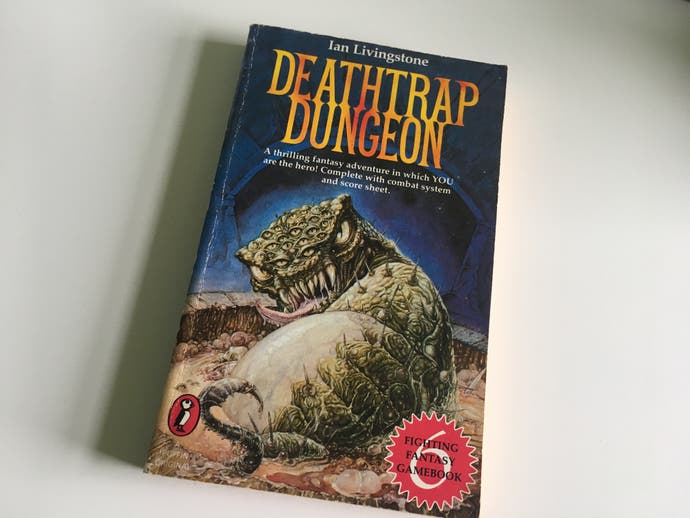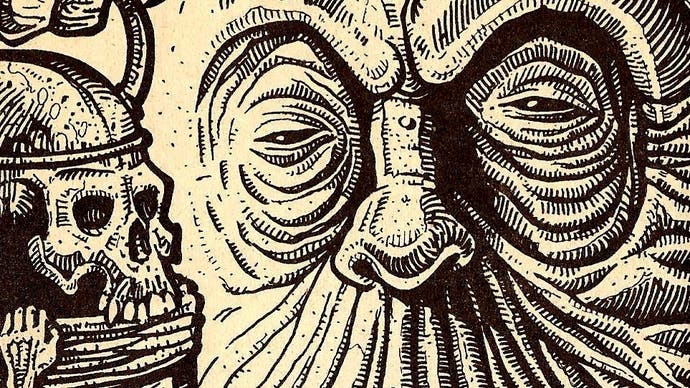Adventure books and their ageless illustrations
Drawn back in.
In my day, we had to use our imagination: an annoying phrase that a few too many people within the older generation have probably flung your way over the years. It's the kind of saying that's almost certainly been in circulation for as long as people have existed - right down to whoever was muttering that, before the existence of fire, 'we' had to use our imagination when it came to sitting in total darkness.
I'm going to use that pesky phrase though, and I'm really sorry. However, in my day, there was no Skyrim, and Link's most recent outing was fun but distinctly limited in scope. Instead, my greatest and most epic adventures were through Fighting Fantasy gamebooks. These were stories that frequently tied together throughout the series, but also required a certain amount of your brain doing the heavy lifting - joining the dots and imagining how things might have been. Yes, you really did have to use your imagination. It wasn't just all there like it is now. Oh no, I've just become old, haven't I?
Also, to be instantly hypocritical, that wasn't always the case. See, one of the beautiful things about Fighting Fantasy books was that they'd reward you every now and then with some stunning artwork. Let's go back a little though. There's a chance you've never even experienced the wonders of a true Fighting Fantasy book.
Those books! Each story was laid out exactly like a regular piece of fiction. Except, after reading a few paragraphs, you'd be given choices. There'd be a short description of your options. Often gloriously terrible options. Do you want to go down that creepy looking corridor to the left or the turning to the right where you can hear distant wailings? Picking an option would take you to a completely different (and often distant) page, and so the process would continue. Every now and then, you'd fight a goblin or two, by completing numerous dice throws in a newbie-friendly nod to Dungeons & Dragons.

My favourite was Deathtrap Dungeon. You explored a dungeon in a bid to win great prizes. Of course, the dungeon was liberally scattered with traps and monsters and, invariably, you'd die. Insta-deaths were a common thing as you read. There was no comeback. Not unless you cheated by sneakily holding a finger to the page you were last at, just to see what was going to happen next.
It was a cruel form of entertainment in its way, but gripping too. At this time, 'proper' games were rarely as involved or as convoluted as anything Fighting Fantasy could provide. The only downside was that it was all a bit plain. At least - until it came to that artwork.
The artwork was and remains beautiful. Line drawings of increasingly sinister, terrifying, or simply bizarre creatures, they were the stuff of nightmares and dreams all rolled into one. Much like the greatest pixel art out there, they retain an ageless quality. I can still picture the terrifying image of a Night Stalker - a strange creature with too many teeth and an altogether unnerving disposition. That came from Caverns of the Snow Witch, an adventure that also included the frankly horrific Banshee. It's beautifully disturbing.
Other stories were a bit more harmless looking, if no less tricky to complete (without cheating). Known as the Cretan Chronicles, there were mythological tales to tell, sparking my long term love of all things to do with Ancient Greece. Away from the Fighting Fantasy banner, there were gamebooks based around Sonic the Hedgehog, Mario Bros., and even Lemmings, which feels like a bit of a reach. They're a truly bizarre bunch of titles in their way - almost accepting that there were certain things that games consoles just couldn't achieve just yet.

Typically, they were far more child friendly than anything Fighting Fantasy would think of, but their artwork was still quite delightful. If you were lucky enough to have read the Sonic comic back in the day, you'll recognise some similarities. The artwork was cartoony but distinctly cool, capturing the essence of Sonic's stubborn aloofness and Tails' naivety.
This was all so annoyingly long ago though, so why are we still playing them? I don't mean the recently published Fighting Fantasy adventure gamebook - The Gates of Death - as it's a bit simplified compared to past experiences. Instead, I mean the likes of Tin Man Games' revival of the series. By now, we could simply play a game like Skyrim or The Witcher 3, but there's still that wonderful delight about reading and losing one's self in a book, isn't there? Taking in the artwork while still using a hefty dose of imagination to join the gaps.
I'd argue it's akin to the nostalgia that comes from watching old Charlie Chaplin films. The technology has moved on. We can hear the jokes now, and see more allegedly sophisticated means of telling a story, and yet many of us return to Chaplin or Buster Keaton and laugh until we cry. There's a purity - a mastery - still there to entice a whole new generation. Fighting Fantasy and other adventure gamebooks seem like the gaming equivalent to me. They're one part nostalgia, one part an insight into what came before. Most of all, they're still fun.









